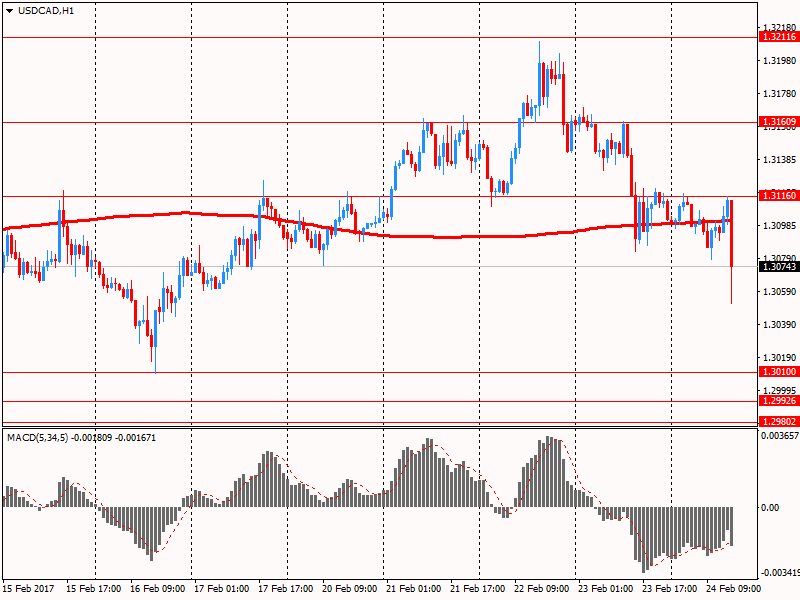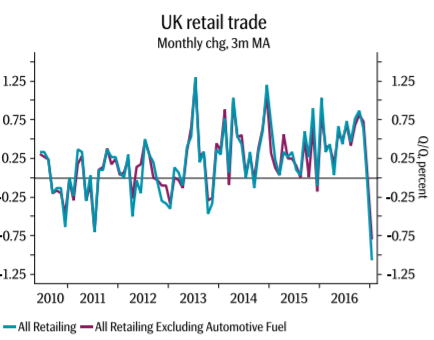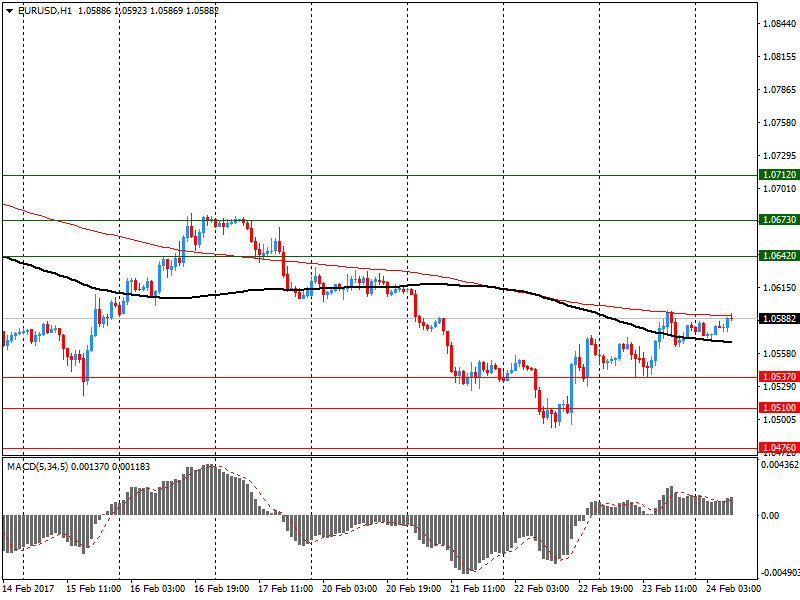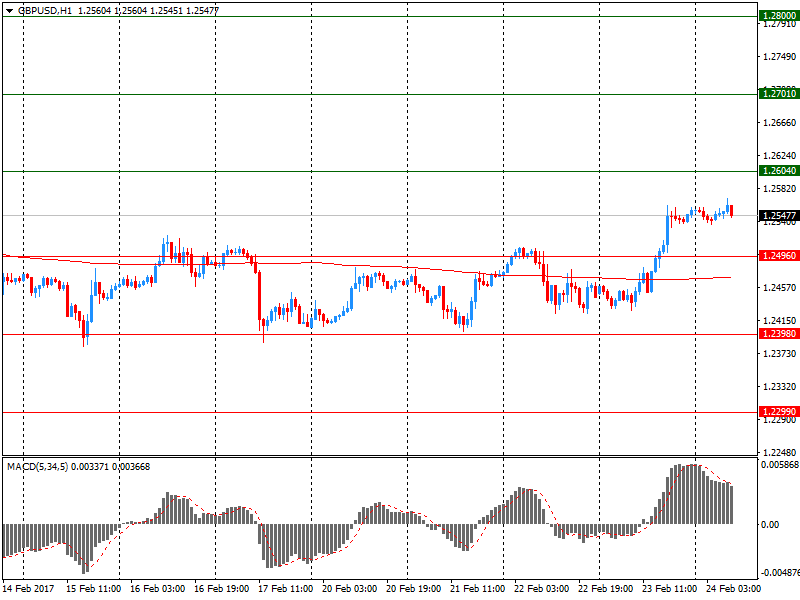Market news
-
15:45
EU's Dombrovskis says hopes greek bailout review can be concluded by March deadline
-
15:17
US consumer confidence remained slightly below the decade peak recorded in January - UoM
While consumer confidence edged upward in late February, it remained slightly below the decade peak recorded in January. Overall, the Sentiment Index has been higher during the past three months than anytime since March 2004. Normally, the implication would be that consumers expected Trump's election to have a positive economic impact.
That is not the case since the gain represents the result of an unprecedented partisan divergence, with Democrats expecting recession and Republicans expecting robust growth. Indeed, the difference between these two parties is nearly identical to the difference between the all-time peak and trough values in the Expectations Index - 64.6 versus 64.4.
While the expectations of Democrats and Republicans largely offset each other, the overall gain in the Expectations Index was due to self-identified Independents, who were much closer to the optimism of the Republicans than the pessimism of the Democrats.
-
15:15
US new home sales rebound in January
Sales of new single-family houses in January 2017 were at a seasonally adjusted annual rate of 555,000, according to estimates released jointly today by the U.S. Census Bureau and the Department of Housing and Urban Development. This is 3.7 percent (±18.5 percent)* above the revised December rate of 535,000 and is 5.5 percent (±25.4 percent)* above the January 2016 estimate of 526,000.
The median sales price of new houses sold in January 2017 was $312,900. The average sales price was $360,900.
-
15:00
U.S.: New Home Sales, January 555 (forecast 575)
-
15:00
U.S.: Reuters/Michigan Consumer Sentiment Index, February 96.3 (forecast 96)
-
13:44
Option expiries for today's 10:00 ET NY cut
EUR/USD 1.0490-1.0501 (EUR 1,442 M) 1.0520-1.0525 (EUR 710 M) 1.0550 (EUR 1,513 M) 1.0575 (EUR 970 M) 1.0585-1.0600 (EUR 403 M) 1.0650-1.0655 (EUR 419 M) 1.0665-1.0675 (EUR 251 M) 1.0700-1.0715 (EUR 1,449 M)
GBP/USD 1.2450-1.2461 (GBP 352 M) 1.2500 (GBP 473 M) 1.2580-1.2590 (GBP 314 M) 1.2600-1.2615 (GBP 213 M)
EUR/GBP 0.8485-0.8500 (EUR 187 M)
USD/JPY 111.00-111.05 (USD 376 M) 111.45-111.55 (USD 330 M) 111.95-112.00 (USD 643 M) 112.20-112.35 (USD 880 M) 112.50 (USD 550 M) 112.75 (USD 970 M) 113.15-113.25 (USD 361 M) 113.50-113.65 (USD 700 M) 113.70-113.75 (USD 245 M) 114.00-114.10 (USD 1,063 M)
USD/CHF 1.0100-1.0115 (USD 300 M)
AUD/USD 0.7525-0.7540 (AUD 664 M) 0.7600-0.7610 (AUD 396 M) 0.7640-0.7655 (AUD 242 M)
USD/CAD 1.3080-1.3095 (USD 605 M) 1.3100-1.3112 (USD 603 M) 1.3120 (USD 365 M) 1.3150-1.3165 (USD 381 M) 1.3185-1.3200 (USD 330 M) 1.3215-1.3220 (USD 270 M) 1.3285-1.3300 (USD 262 M)
NZD/USD 0.7150-0.7155 (NZD 208 M) 0.7400 (NZD 277 M)
-
13:37
Huge rise for Canadian CPI in January
The Consumer Price Index (CPI) rose 2.1% on a year-over-year basis in January, following a 1.5% gain in December.
Excluding gasoline, the CPI was up 1.5% year over year in January, after posting a 1.4% increase in December.
Prices were up in seven of the eight major components in the 12 months to January, with the transportation and shelter indexes contributing the most to the year-over-year rise in the CPI. The food index declined on a year-over-year basis for the fourth consecutive month.
The transportation index rose on a year-over-year basis, up 6.3% in January after a 3.0% gain in December. The gain in January was led by gasoline prices, which posted their largest increase since September 2011, up 20.6% in the 12 months to January. The increase was partly attributable to higher crude oil prices in January, as well as a monthly decline one year earlier. On a year-over-year basis, the purchase of passenger vehicles index rose more in January (+3.8%) than in December (+2.6%). This acceleration was partly attributable to the greater availability of new 2017-model-year vehicles.
-
13:36
-
13:30
Canada: Bank of Canada Consumer Price Index Core, y/y, January 1.7%
-
13:30
Canada: Consumer price index, y/y, January 2.1% (forecast 1.6%)
-
13:30
Canada: Consumer Price Index m / m, January 0.9% (forecast 0.3%)
-
13:00
Orders
EUR/USD
Offers 1.0600-05 1.0620 1.0635 1.0650 1.0680 1.0700
Bids 1.0575-80 1.0550 1.0530 1.0500 1.0480-85 1.0450
GBP/USD
Offers 1.2565 1.2575-80 1.2600 1.2630 1.2650
Bids 1.2530 1.2500 1.2480 1.2450 1.2425-30 1.2400
EUR/GBP
Offers 0.8460 0.8485 0.8500 0.8520 0.8535 0.8550
Bids 0.8420 0.8400 0.8385 0.8350 0.8300
EUR/JPY
Offers 119.50 119.85 120.00 120.30 120.50
Bids 119.00 118.80 118.50 118.30 118.00
USD/JPY
Offers 112.85 113.00 113.25-30 113.50 113.80-85 114.00-05
Bids 112.50 112.30 112.00 111.85 111.50 111.00
AUD/USD
Offers 0.7720 0.7735 0.7750 0.7780 0.7800
Bids 0.7680 0.7665 0.7650 0.7620 0.7600
-
11:17
China overtook the United States and France as the largest trading partner of Germany
As shown by the data, for the first time China has become the most important trading partner of Germany in 2016, overtaking the US, which fell back to third place behind France.
German imports from China and exports to China rose to 170 billion euro in 2016, according to the data of the Federal Bureau of Statistics.
This improvement is likely to be welcomed by the German government, which has set a goal to protect the global free trade after the US president Donald Trump threatened to impose import taxes and his chief adviser blamed Germany to use the weakness of the euro to stimulate exports. German Vice Chancellor Sigmar Gabriel even suggested that the European Union must reorient its economic policies towards Asia, if the Trump administration will stick to the policy of protectionism.
-
10:45
German foreign ministry spokesman says asked about trade with U.S, we don't want to avoid having discussions with anyone
-
10:12
Le Pen will agree to be questioned by police but only after elections this year - Lawyer
-
10:11
UK net mortgage borrowing was 2.4% last month
The BBA's latest high street banking data shows that consumer borrowing through overdrafts, loans and credit cards grew at an annual rate of 6.7%.
Gross mortgage borrowing totalled £13.8 billion in January, 6.3% higher than the same period last year.
Re-mortgaging approvals in January were 15.7% higher than January 2016, driven by historically low interest rates.
Net mortgage borrowing was 2.4% last month, higher than in January 2016.
-
09:30
United Kingdom: BBA Mortgage Approvals, January 44.7 (forecast 41.9)
-
09:03
Bundesbank’s Dombret: Brexit Is a Two Way Street For Market Access
-
08:14
Today’s events
-
At 15:00 GMT US Inflation expectations from the University of Michigan
-
At 18:00 GMT The number of US drilling rigs operating - Baker Hughes data
-
-
07:45
France: Consumer confidence , February 100 (forecast 100)
-
07:39
We are negative on the UK economy going forward although it did well in H2 last year. How to trade GBP/USD - SEB
"We are negative on the UK economy going forward although it did well in H2 last year. In particular household and capital spending seem vulnerable from the impact of growing political uncertainty created by the upcoming divorce from the EU. Retail sales have already showed signs of slowing and will likely continue to do so.
However, these reasons for GBP weakness are currently overshadowed by political risks elsewhere, which have caused a small recovery of the GBP. We argue this recovery is just temporary and is unlikely to last.
Nevertheless, the net short exposure to GBP is still much larger than it has been historically. Consequently, sterling may well continue to recover in coming weeks as long as market players focus elsewhere. Not so much because things have improved in any particular way in the UK but more because political uncertainty and risks have increased elsewhere. This might well continue until the second round of the French presidential elections in May.
However, EUR/GBP around 0.83 would represent a compelling buy with a target closer to 0.90. Alternatively we suggest selling GBP/SEK around 11.50-11.70 for the currency pair to reach levels below 10.50 in the second half of this year".
Copyright © 2017 SEB, eFXnews™
-
07:26
Options levels on friday, February 24, 2017
EUR/USD
Resistance levels (open interest**, contracts)
$1.0712 (3286)
$1.0673 (2844)
$1.0642 (3478)
Price at time of writing this review: $1.0588
Support levels (open interest**, contracts):
$1.0537 (5462)
$1.0510 (5437)
$1.0476 (4885)
Comments:
- Overall open interest on the CALL options with the expiration date March, 13 is 73913 contracts, with the maximum number of contracts with strike price $1,0800 (4726);
- Overall open interest on the PUT options with the expiration date March, 13 is 84095 contracts, with the maximum number of contracts with strike price $1,0600 (5462);
- The ratio of PUT/CALL was 1.14 versus 1.13 from the previous trading day according to data from February, 23
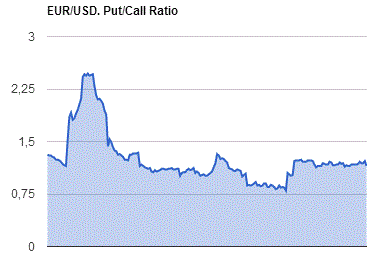
GBP/USD
Resistance levels (open interest**, contracts)
$1.2800 (3129)
$1.2701 (2385)
$1.2604 (2183)
Price at time of writing this review: $1.2547
Support levels (open interest**, contracts):
$1.2496 (2328)
$1.2398 (1675)
$1.2299 (3260)
Comments:
- Overall open interest on the CALL options with the expiration date March, 13 is 34064 contracts, with the maximum number of contracts with strike price $1,2800 (3129);
- Overall open interest on the PUT options with the expiration date March, 13 is 37423 contracts, with the maximum number of contracts with strike price $1,2300 (3260);
- The ratio of PUT/CALL was 1.10 versus 1.09 from the previous trading day according to data from February, 23
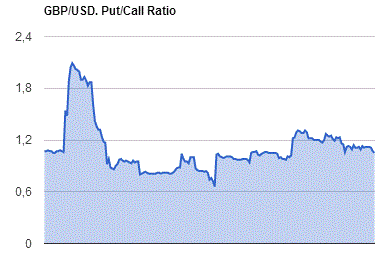
* - The Chicago Mercantile Exchange bulletin (CME) is used for the calculation.
** - Open interest takes into account the total number of option contracts that are open at the moment.
-
07:24
Trump says he supports some form of border tax, without offering specifics - Reuters interview
-
07:21
Fitch on india banking sector - creation of a 'bad bank' may face significant logistical difficulties
-
A larger-scale bad bank with government backing might have more
-
Believe government will eventually be required to provide more than $10.4 bln that it has earmarked for capital injections by fye19
-
Expect stressed-asset ratio to rise over coming year from 12.3% recorded at end-september 2016
-
-
07:12
Russia raised gold holdings by 29.9 tonnes to 1,645.194 tonnes in 20IMF data
-
